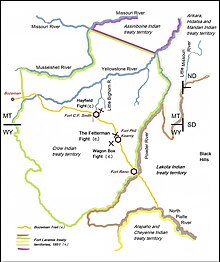
Back حرب الغيمة الحمراء Arabic Guerra de Red Cloud Catalan Red-Cloud-Krieg German Guerra de Nube Roja Spanish Guerre de Red Cloud French Oarloch fan Reade Wolk Frisian Guerra di Nuvola Rossa Italian レッドクラウド戦争 Japanese Wojna Czerwonej Chmury Polish Războiul lui Red Cloud Romanian
| Red Cloud's War | |||||||
|---|---|---|---|---|---|---|---|
| Part of the Sioux Wars | |||||||
 Battle locations | |||||||
| |||||||
| Belligerents | |||||||
|
Crow Nation | |||||||
| Commanders and leaders | |||||||
| Strength | |||||||
| 1,500–2,000 | ||||||
| Casualties and losses | |||||||
| ~200 killed[1] | Unknown | ||||||
Red Cloud's War (also referred to as the Bozeman War or the Powder River War) was an armed conflict between an alliance of the Lakota, Northern Cheyenne, and Northern Arapaho peoples against the United States and the Crow Nation that took place in the Wyoming and Montana territories from 1866 to 1868. The war was fought over control of the western Powder River Country in present north-central Wyoming.
In 1863, European Americans had blazed the Bozeman Trail through the heart of the traditional territory of the Cheyenne, Arapaho, and Lakota.[2] It was the shortest and easiest route from Fort Laramie and the Oregon Trail to the Montana gold fields. From 1864 to 1866, the trail was traversed by about 3,500 miners, emigrant settlers and others, who competed with the Indians for the diminishing resources near the trail.[2]
The United States named the war after Red Cloud, a prominent Oglala Lakota chief allied with the Cheyenne and Arapaho. The United States army had built forts in response to attacks on civilian travelers, using a treaty right to "establish roads, military and other post".[3] All three forts were located in 1851 Crow Indian territory and accepted by these Indians.[4] The Crow believed they guarded their interests best by cooperating with the US army.[5]
Red Cloud's War consisted mostly of constant small-scale Indian raids and attacks on the soldiers and civilians at the three forts in the Powder River country, wearing down those garrisons. The largest action of the war, the Fetterman Fight (with 81 men killed on the U.S. side), was the worst military defeat suffered by the U.S. on the Great Plains until the Battle of the Little Bighorn in the Crow Indian reservation ten years later.[6] " ... the most dramatic battles between the army and the Dakota [in the 1860s and 1870s] were on lands those Indians had taken from other tribes since 1851."[7]
With peace achieved under the Treaty of Fort Laramie in 1868, the Lakota and their allies were victorious. They gained legal control of the western Powder River country, took down the forts and permanently closed the Bozeman trail. The Crow lost their hunting grounds in the Powder River region to their enemies.[8] With the treaty, "... the [United States] government had in effect betrayed the Crows, who had willingly helped the army to hold the posts for two years".[9] The victory of the Lakota and their allies endured for eight years until the Great Sioux War of 1876, when the US resumed taking their territories, including the sacred Black Hills.[10] In a 1980 Supreme Court case, United States v. Sioux Nation of Indians, the court ruled that tribal lands covered under the treaty had been taken illegally by the US government, and the tribe was owed compensation plus interest. As of 2018 this amounted to more than $1 billion.
- ^ Price, Catherine The Oglala People, 1841–1879: A Political History Lincoln: U of NE, 1996, p. 64. Carrington's total casualties from July to December 1866 were 96 soldiers and 58 civilians dead. Additional soldiers and civilians killed in 1867 bring the total number of white deaths up to about 200.
- ^ a b Fort Phil Kearney/Bozeman Trail Association Archived 2013-10-29 at the Wayback Machine, accessed 12 Aug 2012
- ^ Kappler, Charles J.: Indian Affairs. Laws and Treaties. Washington, 1904. Vol. 2, p. 594. http://digital.library.okstate.edu/kappler/Vol2/treaties/sio0594.htm Archived 2014-08-12 at the Wayback Machine
- ^ The forts were located west of the Powder River, which was the dividing line between the Crow territory and the Lakota territory according to the Fort Laramie Treaty of 1851. (see this)
- ^ Hoxie, Frederick E.: Parading through History. The Making of the Crow Nation in America, 1805–1935. Cambridge, 1995, p. 91. See also Rzeczkowski, Frank: "The Crow Indians and the Bozeman Trail," Montana, The Magazine of Western History, Vol. 49, No. 4 (Winter 1999), pp. 30–47. Papers relating to Talks and Councils held with the Indians in Dakota and Montana Territories in the Years 1866–1869. Washington, 1910, p. 67.
- ^ Kappler, Charles J.: Indian Affairs. Laws and Treaties. Washington, 1904, Vol. 2, p. 1008.
- ^ Ewers, John C.: "Intertribal Warfare as a Precursor of Indian-White Warfare on the Northern Great Plains". Western Historical Quarterly, Vol. 6, No. 4 (Oct. 1975), pp. 397–410, quote p. 408.
- ^ Kappler, Charles J.: Indian Affairs. Laws and Treaties. Washington 1904. Vol. 2, pp. 998–1003. http://digital.library.okstate.edu/kappler/Vol2/treaties/sio0998.htm Compare the 1851 Crow treaty territory with the 1868 unceded Indian Territory of the Lakota.
- ^ Dunlay, Thomas W.: Wolves for the Blue Soldies. Indian Scouts and Auxiliaries with the United States Army, 1860–90. Lincoln and London, 1982, p. 40
- ^ Brown, Dee (1970). Bury My Heart at Wounded Knee, ch. 6. Bantam Books. ISBN 0-553-11979-6.
© MMXXIII Rich X Search. We shall prevail. All rights reserved. Rich X Search